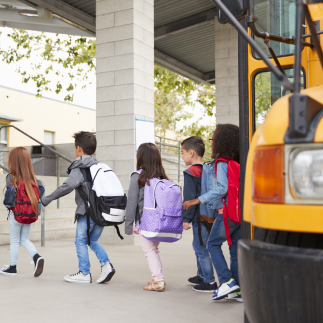What’s Next for California Schools?

Summary
The Getting Down to Facts II (GDTFII) project, released in September 2018, assessed the state of preK–12 education in California. As year 2 of Governor Newsom’s term begins, this report provides a progress update on three areas of concern raised by the research findings and highlights what may be coming next.
GDTFII Finding 1: California needs a continued focus—through multiple approaches—on its large achievement gaps, including enhanced early childhood education.
2019 statewide test results showed slight improvements, but students of color and those from low-income families continued to lag behind their peers. The problem starts early, as a lack of access to high quality early childhood education (ECE) leaves too many children behind. The state began to address this issue with an increase in funding and by starting work on an updated data system and a Master Plan for Early Learning and Care. K–12 staffing shortages and teacher distribution issues contribute to the gap and they are receiving increased policy attention as well, with significant investments proposed in the 2020-21 budget.
GDTFII Finding 2: California’s education system needs capacity building in order for educators and others to identify and implement effective improvement strategies.
California’s Statewide System of Support benefited from increased funding and a focus on strengthening county office capacity to support schools and districts. Local leaders praise the emphasis on assistance over compliance but say the effort is uneven and inadequately funded. Policies to improve support for English learners were introduced in 2019-20 and impact will be studied through a new proficiency assessment and a teacher observation protocol, to be completed in fall 2020. To bolster continuous improvement efforts, the 2019–20 budget provided $10 million for a longitudinal student-level data system and one of the first steps will be matching student records between K–12 and higher education. With two bills passed in 2019, charter school oversight and governance also garnered policy attention.
GDTFII Finding 3: Funding for schools remains short of adequate, and pensions, special education, and facilities could destabilize the system or worsen inequities.
California’s 2019–20 budget increased K–12 funding by $2.8 billion. While substantial, the increase falls well short of what schools need. A measure to provide additional funding may appear on the November 2020 ballot and, in March, voters will decide on a statewide school facilities bond. Both special education and pensions received attention from state leaders in 2019. Added funding for special education will be temporary unless statutory changes to the special education system are enacted in 2020. The 2019–20 budget provided some financial relief for districts related to pensions, but state leaders did not address the persistent accrual of unfunded liabilities at the heart of the pension problem.
Perry, M., Myung, J., & Hough, H. J. (2020, February). What’s next for California schools? A progress report one year after Getting down to facts II [Report]. Policy Analysis for California Education. https://edpolicyinca.org/publications/whats-next-california-schools



